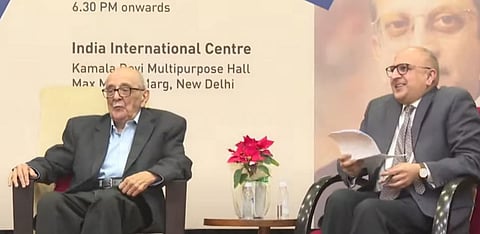

Senior advocate Fali S. Nariman, speaking at the second Ashok Desai memorial lecture, stated that the majority judgment in Kesavananda Bharati case, which established the basic structure doctrine, was rightfully criticised.
—
"What is that word by which we will remember him? It was recognised as the word of the year by the Oxford Dictionary: rizz (charisma)," is how Fali S. Nariman, senior advocate and former Solicitor General of India, described the personality of former Attorney General of India, Ashok Desai.
Nariman was the guest of honour at the second Ashok Desai memorial lecture on Usable Past: Constructing Histories of Constitutionalism.
The guest speaker at the event was eminent Indian political scientist and professor at Princeton University Pratap Bhanu Mehta.
The event was also attended by many other dignitaries, including judges of the Supreme Court.
"In Kesavananda, in reading implied limitations in the amending power, the Supreme Court had certainly made a new law," said Nariman.
He briefly examined the judiciary's interference with the amending power of the Parliament vis-à-vis the Constitution of India.
Describing this interference as a concern for lawyers and political authorities, Nariman told the audience that in the initial twenty years after the promulgation of the Indian Constitution, Supreme Court judges faced a dilemma on whether they were empowered to invalidate a constitutional amendment for violating Part III of the Constitution. The Indian Constitution was silent on this issue, he said.
"The judges of the Supreme Court plumbed the depths of the silences in the world's longest Constitution for some limitations on the amending powers," he said.
Ultimately, the Supreme Court found limitations to the amending power of the Parliament in Kesavananda Bharati versus State of Kerala (1973).
Nariman told the audience that the majority view in Kesavananda Bharati was criticised as an "unwarranted assertion of naked political powers in the guise of judicial interpretation".
Explaining his opinion, Nariman said that the judgment, which laid down the basic structure doctrine, had upset the balance of powers in the Indian Constitution.
He said: "By propounding the basic structure, guardians of the Constitution, it was said, had become the guardians over the Constitution."
Nariman explained that the criticism against the majority judgment in Kesavananda was valid because what the court had done was judicial governance.
However, he explained that the latter set of events showed how the doctrine of basic structure ultimately came to the rescue of democracy in India.
In 1971, the Indian National Congress obtained a majority in the general elections and Nariman described this moment as India's moving towards a "grave constitutional crisis".
However, things took a drastic turn, or as Nariman called it, "fate intervened".
On June 12, 1975, the then Prime Minister Indira Gandhi lost an election petition against Raj Narain of Janata Party filed in the Allahabad High Court on the grounds of electoral malpractice. As a consequence, Gandhi with overwhelming majority was unseated.
During the pendency of the appeal to the Supreme Court, an internal emergency was imposed on June 25, 1975.
Gandhi passed the Constitution (Thirty-Ninth Amendment) Act, 1975 which barred the election of a sitting Prime Minister to be challenged before a court of law.
Nariman described that Gandhi could do this because of the unfettered power of amendment under Article 368 of the Constitution. The thirty-ninth amendment was an attempt to reverse the judgment of the Allahabad High Court.
He said: "Fortunately for the nation, the court resisted this crude attempt relying for the first time after Kesavananda on basic structure theory of the Constitution".
Nariman said that it was this decision and not the majority decision in Kesavananda alone that helped cement the basic structure theory.
Ultimately, the Supreme Court held that free and fair elections are part of the basic structure of the Constitution, so fundamental that it is beyond the reach of the amending powers of the Constitution.
The court said: "Legislatively validating an invalid election without changing the law that makes the elections invalid would toll the death knell of a democratic Constitution and making an election immune from challenge and prevent questioning of an election before any forum was subversive of the principle of free and fair elections in a democracy."
Nariman said: "This decision constitutes the highwater mark in the assertion of the court's judicial power in the teeth of what was a very determined majority regime."
Mehta described the basic structure doctrine as the history that arrests time of eternal values, that is, the peak and summit of constitutionalism has been reached with the basic structure.
The first Ashok Desai Memorial was organised last year which was delivered by Chief Justice of India Dr D.Y. Chandrachud.